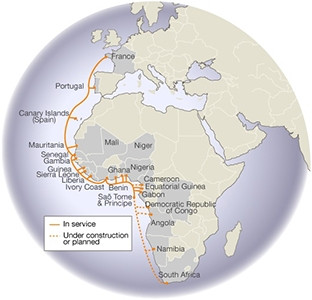
The Africa Coast to Europe (ACE) submarine cable system is being extended to SA.
The ACE submarine communications cable is a system along the west coast of Africa managed by a consortium of 19 operators and administrations headed by French telecommunications giant, Orange.
Yesterday, Orange announced the start of the next phase of the ACE submarine cable system to expand broadband connectivity and digital services in Africa.
The second phase will see a 5 000km extension from island of Sao Tom'e and Principe, in the Gulf of Guinea, to SA that "will further strengthen the role ACE is playing in critical infrastructure development in the continent", Orange says in a statement.
Today, nearly 12 000km of fibre-optic cable is already used to connect 18 countries: France, Portugal, the Canary Islands (Spain), Mauritania, Senegal, Gambia, Guinea, Sierra Leone, Liberia, C^ote d'Ivoire, Benin, Ghana, Nigeria, Equatorial Guinea, Gabon, and S~ao Tom'e and Pr'incipe. Two landlocked countries, Mali and Niger, are connected via a terrestrial extension.
When phase two is completed, ACE will cover a total distance of 17 000km and will allow up to 25 countries to access high-speed Internet.
SA is currently connected to the rest of the world through five submarine cables - WACS, Seacom, SAT-3, SAFE, and EASSy - offering multiple terabits of bandwidth. From 1993 to 2002, the country was only served through the SAT-2 submarine cable.
Mark McCallum, director and head of global services Africa at Orange Business Services, notes, in just over a decade, SA has moved from pure dependency on SAT-3/SAFE (2002) to the addition of Seacom (2009), EASSy (2010) and WACS (2012).
According to Orange, ACE uses the most advanced high-speed broadband fibre-optic technology - wavelength division multiplexing - that allows the capacity to be increased as and when it is needed without additional submarine work being required.
Overall capacity will be boosted to 12.8Tbps using 100Gbps technology, which supports high-capacity networks, Orange says.
The consortium has invested around $700 million in the construction of the cable, which includes $250 million from the Orange Group and its subsidiaries. The cable was manufactured by Alcatel Submarine Networks and was laid by ships from ASN and France Telecom Marine.
Share